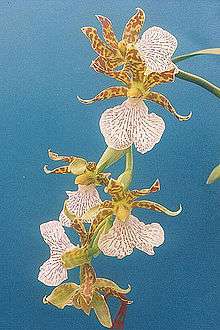Zygopetalum
Zygopetalum (abbreviated Z.[2]) is a genus of the orchid family (Orchidaceae) (subfamily Epidendroideae, tribe Maxillarieae, subtribe Zygopetalinae), consisting of fourteen currently recognized species.[1][3]
| Zygopetalum | |
|---|---|
 | |
| Zygopetalum maculatum | |
| Scientific classification | |
| Kingdom: | Plantae |
| Clade: | Tracheophytes |
| Clade: | Angiosperms |
| Clade: | Monocots |
| Order: | Asparagales |
| Family: | Orchidaceae |
| Subfamily: | Epidendroideae |
| Subtribe: | Zygopetalinae |
| Genus: | Zygopetalum Hook., 1833 |
| Type species | |
| Zygopetalum mackayi (syn of Z. maculatum) Hook., 1833 | |
| Synonyms[1] | |
|
Zygopetalon Rchb., spelling variation | |
Name
This orchid's generic name, derived from the Greek word zugón, means "yoke". It refers to the yoke-like growth at the base of the lip.
The genus name has Z. as a unique abbreviation among orchid genera.[2]
Distribution
They occur in humid forests at low- to mid-elevation regions of South America, with most species in Brazil.[1]
Description
Most species are epiphytes, but some are terrestrials with glossy, strap-like, plicate leaves, which are apical, oblong or elliptic-lanceolate, acute or acuminate. These orchids have a robust growth form. Their ovoid-conical pseudobulbs are deciduous.
They produce an erect, 60-centimeter-long, few-flowered to several-flowered, racemose inflorescence that grows laterally and is longer than the leaves. Their prominent bracts equal the length of the ovary. They are known for their fragrant, waxy, and long-lived flowers with multiple blooms in shades of green, purple, burgundy, and raspberry with several patterns.
Cultivation
They are known for their ease of culture and are much in demand as excellent cut flowers.

Species
Species accepted as of June 2014:[1]
- Zygopetalum brachypetalum Lindl. - Brazil
- Zygopetalum crinitum G.Lodd. - Brazil
- Zygopetalum ghillanyi Pabst - São Paulo
- Zygopetalum graminifolium Rolfe - São Paulo, Rio de Janeiro
- Zygopetalum maculatum (Kunth) Garay - spotted zygopetalum - Peru, Bolivia, Brazil
- Zygopetalum maxillare G.Lodd. - Brazil, Paraguay, Argentina
- Zygopetalum microphytum Barb.Rodr. - Minas Gerais, São Paulo
- Zygopetalum pabstii Toscano - Espírito Santo
- Zygopetalum pedicellatum (Sw.) Garay - southeastern Brazil
- Zygopetalum reginae Pabst - São Paulo
- Zygopetalum sellowii Rchb.f. in W.G.Walpers - Brazil
- Zygopetalum silvanum V.P.Castro & Campacci - Bahia
- Zygopetalum sincoranum V.P.Castro & Campacci - Bahia
- Zygopetalum triste Barb.Rodr. - Minas Gerais
References
- Kew World Checklist of Selected Plant Families
- Alphabetical List of Standard Abbreviations for Natural and Hybrid Generic Names, RHS, 2007. https://www.rhs.org.uk/plants/pdfs/plant-registration-forms/orchid-name-abbreviations-list.pdf
- Pridgeon, A.M., Cribb, P.J., Chase, M.C. & Rasmussen, F.N. (2009). Epidendroideae (Part two). Genera Orchidacearum 5: 1-585. Oxford University Press, New York, Oxford.
External links


- Orchidroots.org Zygopetalum Species